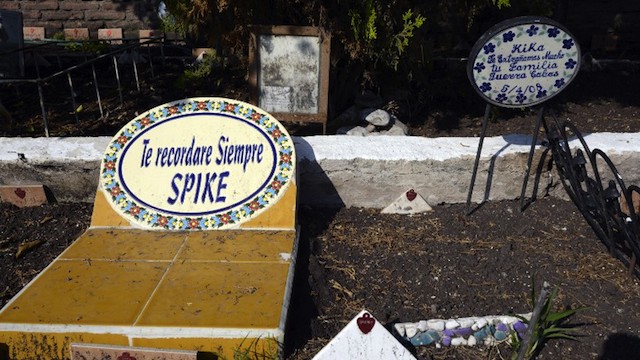SUMMARY
This is AI generated summarization, which may have errors. For context, always refer to the full article.

CORREGIDORA, Mexico – The Narvaez family congregated around the tiny dirt grave of their loved one on Mexico’s Day of the Dead, laid a handful of marigolds and recalled the joy he brought to their home.
Mexicans flock to cemeteries every November 1 and 2 to honor their dead, bringing them flowers, their favorite foods or tequila in a centuries-old tradition mixing pre-Hispanic and Catholic beliefs.
Except the Narvaez clan was visiting a different kind of family member, one that died last year after a suspected poisoning took his ninth life: Their beloved Siamese cat Facundo.
“Animals are part of the family too. They’re affectionate, like humans,” said 38-year-old jewelry shop owner Raul Narvaez, visiting the grave with his wife and two teenage sons.
Narvaez crouched down to wipe the dust off the tiny ceramic headstone at the pet cemetery of Corregidora, a suburb of the city of Queretaro in central Mexico.
Pets named Elvis, Ozzy, Cherry and Zeus are among more than 1,000 animals buried in the cemetery that veterinarian Manuel Solorio has maintained for three decades.
Dotted with lime trees and cactus, the burial site mostly contains dogs, but there are some cats, a rabbit, a hamster and a mouse.
The care put into the graves points to the evolving relationship between Mexicans and their estimated 26 million cats and dogs, in a country still confronting animal cruelty but that also spends $2.2 billion in pet products.
Most graves are marked with a small tile and a dog tag, but several are decorated with fences, flowers and their animal’s favorite ball, penguin squeaky toy or teddy bear.
“People have changed the way that they think about pets. Before, it was a just an animal. Now, they’re like children,” said Solorio, who charges between $38 and $76 to bury pets, depending on their size.
In the past, it was common for Mexicans to leave their dead animals in a dumpster or bury them in backyards.
Like a son
At the unnamed cemetery, Azucena Olvera used scissors to trim the overgrown grass on Coffy’s grave, surrounded by a white fence. She placed a new picture of her poodle along with three lollipops, his favorite treat.
“He was like our son,” said Olvera, a 40-year-old accountant who said she still feels Coffy’s spirit in her house since he died in May aged nine.
Carmen Solares and her two daughters placed a picture of their American cocker spaniel, Negra, at a Day of the Dead altar outside the cemetery’s office with other photos of a schnauzer, a doberman and a rabbit named Tamborcita (Little Drummer).
Others left Day of the Dead marigolds called cempasuchiles, dog treats and a poem as offerings on a day Mexicans believe the spirits of their loved ones come back to visit them.
Dignified farewell
The number of pet cemeteries in Mexico is unknown, but crematoriums for domestic animals are now an option too.
Pet owners spend between $135 and $200 to cremate their animals at Funeral Pet, a Mexico City facility that provides families with urns and a room to say goodbye to their pooch or kitty.
Funeral pet, which claims to be Mexico’s first crematorium, conducted 100 services when it opened in 1998. Today, it cremates 3,000 pets a year.
“It’s something that wasn’t done before because we didn’t have this pet culture,” said Alejandro Garcia, the crematorium’s commercial director.
In Mexico City, mobile dog grooming vans offer their services at parks packed with pets. People hire dog walkers and send their pets to spas.
The pet care industry grew by 11 percent to $2.2 billion in 2013, according to Euromonitor International, a London-based market research firm.
The firm says an aging and more educated population marrying later and having fewer children is driving the trend of humanizing pets.
But pets are still getting a bad rap.
Animal rights groups have urged authorities to stop using electrocution to euthanize street dogs while abuse cases are still common.
In July, a man was dubbed “El Matagatos” (The Cat Killer) after he posted pictures on social media of dogs sicced on cats. Another young man caused a stir by publishing a photo of himself with a crucified chihuahua.
“Things have improved a bit but the problem hasn’t been solved,” said Vanessa Salvillo, spokeswoman for APASDEM, an association of almost 100 animal rights groups.
“More people now treat their pets like family members… There is a culture of giving a dignified farewell when people lose a pet they love.” – Rappler.com
Add a comment
How does this make you feel?
There are no comments yet. Add your comment to start the conversation.